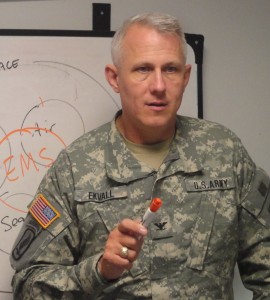Clearing the air on cyber, electronic warfare
EDITOR'S NOTE: Updated with program details
The Army’s electronic warfare experts are feeling misunderstood, and they’re worried that those misunderstandings could put them on the losing end in today’s epic budget battles. The head worrier is Army Col. Jim Ekvall, a one-time artillery man who is now chief of the Electronic Warfare Division within the Army's G-3 operations staff at the Pentagon.
>> Updates in bold italics below.
Ekvall wants to seal a place for the EW specialty in the Army’s post Afghanistan future and hitch it to the growing field of cyberwarfare. That’ll mean winning some internal battles and upgrading equipment, much of which was rushed into service in Iraq and Afghanistan to jam improvised explosive devices.
In a perfect world, Ekvall and his compatriots would give electronic warfare officers, known as EWOs or "29s" after their career field designation, a proposed software called the Electronic Warfare Planning and Management Tool. The Army plans to award a contract this month for the planning kit. The EWOs would use it to receive intel about an adversary's comms frequencies and send updates to equipment in the field.
The field equipment could include a new Raytheon-built counter-IED and intel pod that Ekvall hopes will be sent forward, presumably to Afghanistan, for operational assessment on the Army’s Gray Eagle unmanned planes. The pod is called NERO for the Networked Electronic Warfare Remotely Operated system. It can send spectrum info back to intel cells but its main purpose will be to jam frequencies used for triggering IEDs. NERO is just like the pods flown in Afghanistan on two traditionally piloted C-12 planes by Task Force CEASAR, short for Communications Electronic Attack with Surveillance and Reconnaissance.
NERO needs careful testing because the Gray Eagle is a radio controlled plane, and NERO will be jamming radio waves. "We gotta kinda make sure we don’t make the thing crash," Ekvall tells Deep Dive.
A perfect world would also mean buying a new family of Multifunction Electronic Warfare electronics known as MFEW. This is a proposed new start for 2014. A backpack version would let foot soldiers knock out an adversary’s comms or jam a specific frequency, such as one used for triggering IEDs. MFEW might replace the defensive jammers that were rushed onto vehicles in Iraq and Afghanistan, called CREW for Counter Radio-Controlled Improvised Explosive Device Electronic Warfare. The Army tells Deep Dive: "We will conduct a Joint Analysis of Alternatives in the future to determine how much DEA (defensive electronic attack) functionality can be built in and provided by MFEW vice an independent CREW system."
Then there’s EW's bid for a role in cyberwarfare. EW advocates want a place in an Army cyber center of excellence, should one be created. You can’t launch a cyber operation if you don’t control the spectrum, Ekvall says. On top of that, troops in theory could use some of the EW equipment to jump the air gap and load malware into an adversary’s network. “Could you plant a seed in that communication to cause a cyber attack? You absolutely could,” Ekvall says.
When it comes to the relationship between cyberspace and EW, Ekvall wants a bit of history to be remembered. “The realities are the Army’s interest in electronic warfare – and it’s really a re-birth of electronic warfare inside the Army – preceded its now consuming worries and concerns about cyberspace and cyberspace operations. Whereas cyberspace is still trying to figure out what it all means, electronic warfare has already kind of done that.”
Ekvall doesn’t know which parts of this vision will come to pass, and he’s not happy about that. Electronic warfare saw a resurgence in Iraq and Afghanistan, and that’s led to a misperception that EW won’t be important once the war in Afghanistan ends, Ekvall explains.
In his view, EW is not just about blocking IEDs, although he definitely sees the importance of that after riding around Iraq in vehicles equipped with jammers. “Electronic warfare is about gaining and maintaining an advantage in the electromagnetic spectrum. A piece of that would be counter IED. A piece of that would be counter comms. A piece of that is… protecting your own precision-guided munitions and your own ability to use, say, satellite communications.”
In the world according to Ekvall, the fixation on jamming is the foundation for all the misunderstandings about EW from the Pentagon to Capitol Hill.
EW’s confusing nomenclature hasn’t helped either. A case in point: The Army manages EW acquisitions within its Intelligence Electronic Warfare & Sensors office, called IEW&S. The EW equipment managed there is collectively known as IEWS, for the Integrated Electronic Warfare System.
The potential for confusion matters at the decision-making levels.
“Things that are more well understood have greater chances of success in this very resource constrained environment that we’re working in right now,” Ekvall says.
5 Comments
Trackbacks/Pingbacks
- Clearing the air on cyber, electronic warfare | Deep Dive Intel | Red-DragonRising - [...] on Scoop.it – Chinese Cyber Code ConflictSee on www.deepdiveintel.com This entry was posted in Uncategorized. Bookmark the…




It’s interesting that there doesn’t seem to be a clear line between Cyber and EW and that many are concerned that EW will be forgotten when we pull out of Afghanistan. Carl Sagan said “We live in a society exquisitely dependent on science and technology, in which hardly anyone knows anything about science and technology.” This is true when we try to explain the differences to people who don’t understand the technologies. Cyber is digital inside a computer, EW is Analog (RF) through the airwaves. The RF is the carrier for what can be digital effects, including Cyber but a truck carrying tomatoes isn’t a tomato. EW is instant, Cyber can be but it can also be strategic. STUXNET was not tactical or instantaneous. If the bad guy on the other side launches a missile at me, I want speed of light, RF protection. I don’t want to wait for the operator to open a file with a worm in it. I may wish that worm had been activated yesterday – That would be Cyber, possibly delivered via an EW system, or maybe via an email or a thumb drive. The delivery vehicle is not the tomato.
Regarding leadership forgetting about the value of EW, I’m an old guy but I can remember all too clearly dozens of videos of IED explosions, hundreds of videos of wounded soldiers. I feel an obligation, as an EW guy/advocate to remind those people who forget. I feel I owe it to the soldiers on the ground, the sailors on ships and the pilots and aircrew in airplanes to not let EW be forgotten, to fight for the appropriate share of DoD interest and funding. There are people in key places who also have an obligation because of their jobs and because of the 18 year old from Iowa and his/her family who depend on us to protect their precious child. There has NEVER been enough money. That means we have to do the best we can within the money allocated, just like we’ve done for decades, in times of plenty and in times of little.
Electronic Warfare and spectrum dominance should be central to ANY cyber discussion. There are a garden variety of ways that one can take down a network that have positively NOTHING TO DO WITH A VIRUS, and everything to do with network time, bit-error, Signal/noise, encryption synch, modulation, framing, etc. We have fallen in love with the allure of computer attacks….Who cares if your computer is being attacked if you have no link to it? Who cares if you have a fix for a computer attack if you have no way to send it?
As far as I am concerned we are dancing on an atomic hand grenade if we dont address the full ramifications of a threat….and frankly this has zip to do with IEDs and everything to do with comms and networks…wireless or otherwise.
Wow, Great article! So….. Are we going to take full unfettered control of CREW? Are we going to control the effects of NERO? Are we going to be anything but be the coordination and integration experts? I know a lot of you are wanting this CYBER thing to be our new focus but do we even know the basic fundamentals of EW (EA, EP, ES)? The 29 Series has so much potential to do and be more than what we’re currently tasked to accomplish. I look forward to this coming year to see what direction we will be going.
I’ve just come back from a great EW Conference in Cologne. We had British soldiers and Royal Marines just back from Helmand Province Afghanistan brief about the continual electronic surveillance that drives information exploitation, situational awareness and ISR; about electronic defence against IEDs and the very occasional use of electronic attack. Frequently all these are combined in full spectrum manoeuvre operations against insurgents. A 2-star NATO Force Commander briefed about the importance off all electromagnetic operations in warfare today. There were many more great briefings almost all predicated on NATO’s acceptance of the EM environment or domain as an operational manoeuvre space and the adoption of simple terminology understood by both operators and critically Commanders. As Col Jim Ekvall notes confusing nomenclature is not helping the US Army. Finally, the 29 Series, as an earlier comment notes, has so much potential. Maybe recognizing the EM domain and all that goes with it is a step towards unlocking that potential. Worth thinking about anyway.
If you have an RF Signal that enters the RF Receiver and upsets the communicatins data computer, is that EW Jamming or Cyper Attack?